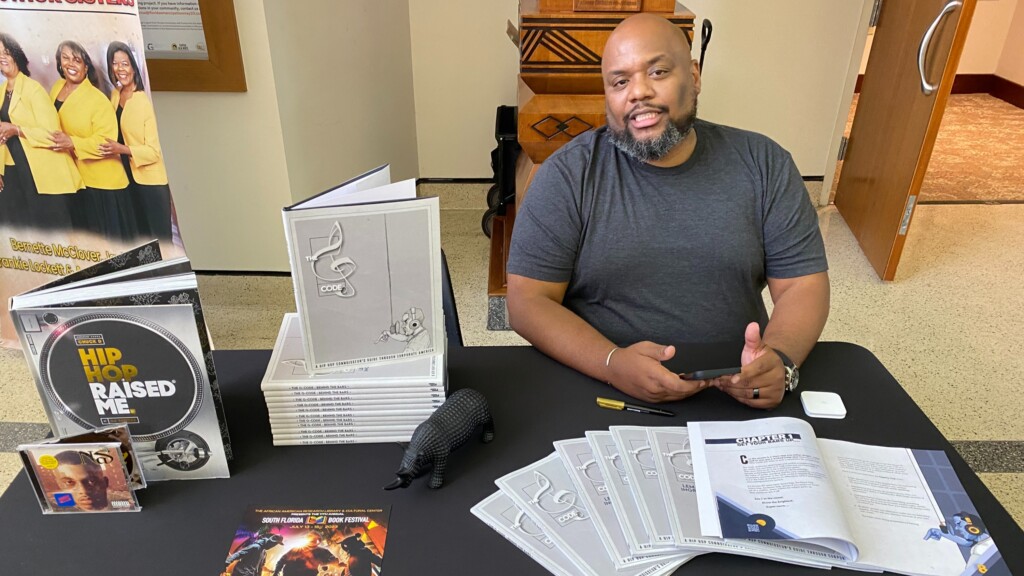The music industry is a business, man!

From a young music enthusiast to a seasoned entrepreneur, Queens-born Lemar Ingram has seamlessly woven the rhythms of street-smart music into the fabric of business strategies. Through his book, The G-Code: Behind The Bars, he invites readers to explore the inspiring narrative that bridges the wisdom of hip-hop with the demands of the corporate boardroom.
Ingram’s journey from a young music enthusiast to a seasoned business leader is both inspiring and relatable. Beginning with a foundation in sound design from the Savannah College of Art and Design, Ingram’s passion for music eventually steered him toward Corporate America. Combining street smarts, artistic flair, and learned corporate knowledge, he has emerged as a dynamic thinker who navigates the corporate world while staying true to his roots.
The New York City author drew inspiration from legendary hip-hop artists such as Jay-Z, Nas and Jadakiss to craft The G-Code. The book takes its cue from the iconic “10 Crack Commandments” and presents corporate commandments in a format deeply rooted in urban cultural wisdom. This innovative approach serves as a bridge between the gritty realities of the streets and modern business strategy.
Ingram delves into how transferable skills from unexpected life experiences, such as freestyling, can be harnessed for success within corporate environments. He showcases how skills often dismissed by traditional executives can translate into eloquent impromptu responses and extemporaneous speech, demonstrating the untapped potential in elements of hip-hop culture.

The G-Code made its debut at the prestigious Museum of Graffiti in Miami’s creative hub, marking a significant milestone. It was also prominently featured at the African American Research Library and Cultural Center’s South Florida Book Festival.
Check out our recent interview with Lemar Ingram below.
Can you share the inspiration behind The G-Code and how the concept of blending hip-hop and corporate commandments came about?
The book was inspired by the Notorious BIGs 10 crack commandments. I thought if there was an instructional song about how to do illegal business why not make one legal? I explored the concept in an article I wrote on LinkedIn called “ I wrote me a Manual”. Years later it became a full book.
How did legendary hip-hop artists like Jay-Z, Nas, and Jadakiss influence the format and content of “The G-Code”? Can you give us an example of how their philosophies are integrated into the corporate strategies discussed in the book?
- In H to the Izzo Jayz focused on the conduct one needs to be successful in a professional setting: I’ll show you how to move in a room full of vultures.
- AZ’s verse on Nas first album speaks to the need to be career-focused and why it’s important to prioritize financial success over being tough.
- Jadakiss’ song My name is Kiss focused on being authentically oneself. There is a line that says, “I’m stuck with what I’m stuck with because I don’t suck…..”
All these lessons had to be decoded and contextualized for the corporate climate.
Tell us about the process of crafting The G-Code as an audiovisual experience. How do you think this approach enhances the reader’s understanding and engagement with the content?
Reading may not be appealing to all members of my target audience. Much like music, for the message to stick, it needs to be audible and repetitive. It was important that each chapter be the ideal length to keep the audience engaged. Adding imagery also increased appeal. For the book to compete with an iPad, Instagram, or video game it had to offer a rich experience.
Could you highlight a few unconventional life experiences and skills that you discuss in the book, and how they can be leveraged for success in the corporate world?
The ability to connect thoughts quickly and communicate them effortlessly (on beat) is a skill often overlooked. If done in the structure of a battle rap, there is also a strategic component to how the information is relayed. This skill allows for effective, efficient communication when presenting and increased sales ability; both talents are assets in a corporate setting.
Can you share a personal experience or anecdote where your passion for music and hip-hop culture has directly influenced or enhanced your approach in the business world?
Prodigy’s line: “Temperamental I snap quick very touchy my attitude is all messed up and real shitty.” While this bravado is accepted in hip-hop culture, it was a lesson of what not to do in a corporate setting. Learning to control one’s emotions and craft succinct, polite responses that conceal offense or stress was essential to my approach to business,
Given your background in sound design and your passion for music, how has this foundation shaped your perspective on creativity and innovation in the corporate environment?
Being a sound designer allowed me to expand creatively and utilize my imagination. This type of nonlinear (but solution-oriented) thinking helped me to solve many problems creatively. Finding solutions when resources were limited, be it financial or otherwise.
The G-Code has been described as a bridge between urban cultural wisdom and modern business strategy. How do you envision this bridge facilitating a better understanding of diverse perspectives in both urban and corporate contexts?
Most of corporate America looks, thinks, and acts the same way. They do not see value in those who don’t talk like them or look like them. This book allows insight into the similarities of both cultures and demonstrates that, at the core the values are similar. Pedigree isn’t always determined by one’s college, and sometimes, it’s a derivative of experiences. This book aims to create a translation of the vernacular of each culture so parties on either side can recognize value.
Could you elaborate on how your education in sound design has influenced your ability to present ideas and concepts effectively, both in the book and in your corporate endeavors?
“Sound can’t lie.” Most people don’t realize how quickly one can discern if something sounds wrong or off. Being a good sound designer is about anticipating what people think something should sound like and matching it to the image. Cultivating that skill has made it easier to formulate presentations that anticipate the needs of stakeholders and customers.
You’ve had the opportunity to showcase The G-Code at prominent events and locations. How has the reception been, and what kind of impact do you hope the book will have on its readers?
The reception to the book is better than I expected. I believe the illustrations really pull people into the book, and the short format makes it digestible. The use of QR codes to link the audio and additional visual elements allows for the book to have lasting appeal. My hope is to highlight possibilities to those who see themselves as outsiders or feel the glass ceiling above. Hopefully, as they embrace authenticity within the rules of corporate America, they can provide additional value via their unique perspective.
What advice would you offer to young entrepreneurs and professionals aiming to merge their passions with their careers, especially when those passions might be rooted in unconventional paths like hip-hop culture?
The synthesis of all you know is where your true power lies. Do not be afraid to combine all your life experiences and apply them within the context of your career. Every environment may have rules, but how you approach these rules is where true creativity lies.



